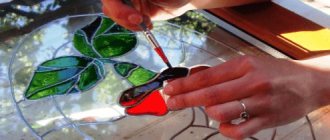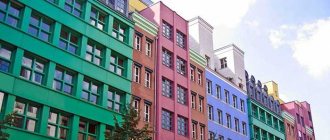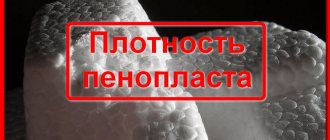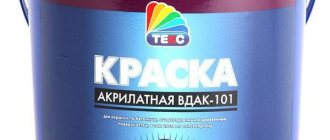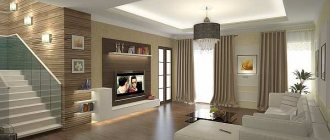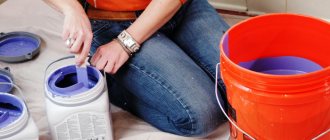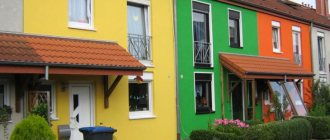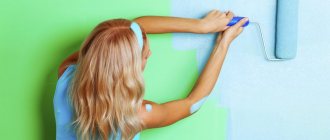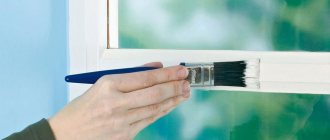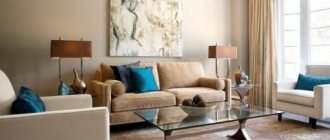Often, when buying paint, we wonder: why are some paints so much more expensive than others? The answer is simple: because of the properties that a particular product has.
Each manufacturer considers it necessary to produce such an assortment of interior paints that will cover all emerging needs. The properties of paints are varied: resistance class to wet abrasion, hiding power class, environmental friendliness, harmlessness to health, type of binder, degree of gloss, strength characteristics, etc.
One of the most important properties, in our opinion, that determine the choice of a particular paint, are the indicators of paint abrasion and paint hiding power. Next, let's try to explain in simple words what these classes mean:
Resistance to wet abrasion.
According to the DIN EN 13300 standard, interior paints and varnishes are divided into coating classes based on resistance to wet abrasion. This classification is not officially accepted in the Russian Federation, but is regularly used to select materials based on the “load-price” ratio.
| DIN EN 13300 | |
| Coverage class | Wet abrasion: coating thickness reduction / cycles |
| Class 1 | < 5 µm at 200 cycles |
| Class 2 | 5-20 µm at 200 cycles |
| Class 3 | 20-70 µm at 200 cycles |
| Class 4 | < 70 µm at 40 cycles |
| Class 5 | > 70 µm at 40 cycles |
Covering power class is:
The hiding power class of acrylic and other interior paints is a very important indicator that determines consumption, surface quality, ability to cover color and the result obtained. Often, paint coverage is the main purchasing characteristic for craftsmen and professionals. In cases where it is necessary to make a quick and budget-friendly renovation, one coat of high-opacity paint may be enough for an impressive result. Thus, the initial higher cost of paint with good hiding power is offset by its consumption.
Gradation by class is carried out on the basis of the manufacturer's data on the hiding power of the paint when painting a black and white base (checkerboard). The contrast ratio determines the difference between a painted surface with a black base and a painted surface with a white base.
Type of paint base
Latin letters mark tinting paint:
- A, VVA, AP
- white paint, can be used in its pure form or tinted in pastel and light shades. - C, D
– colorless paint or paint with a low content of titanium dioxide, a white coloring pigment. This product cannot be used without tinting, since after coloring the color of the base will clearly appear. Mixing type C and D paints is only permissible with bright and saturated colors.
Paint storage conditions
Using several pictograms, the manufacturer shows under what conditions the paint needs to be transported and stored, how to prepare it for use and application features. Violation of these conditions will lead to a decrease in the quality of the paint and its properties.
Apply paint at relative humidity less than 80% and air temperature above +5°C.
Paint doesn't like the cold. The jar can be stored and transported at temperatures above 5°C.
Mix the paint thoroughly before applying.
The time it takes for the paint to dry to touch, that is, when dust does not stick to the paint film. Time between paint coats.
View
Anti-corrosion paint – protects metal surfaces from corrosion resulting from adverse environmental influences. It is technologically advanced, resistant to chemicals and the atmosphere, easy to apply, and does not require preliminary deep cleaning of the surface. This explains its higher price than other paints. Some types of acrylate, water-based, water-dispersion, and latex paints have anti-corrosion properties.
Decorative paint is designed to solve aesthetic problems, the main one of which is creating a unique interior. For example, to recreate an old style or combine several styles in an exclusive interior. Can imitate metal, stone, antique texture, silk.
There is a “chameleon” paint that can change texture and color shades depending on the angle of incidence of light on the surface. At the same time, it should be easy to use, resistant to dry abrasion, durable, and environmentally friendly. As a rule, decorative paint is acrylic.
Heat-resistant paint - used for painting stoves, batteries, pipes, poles, gasoline tanks, radiators and other metal surfaces where resistance to high temperatures, aggressive environments and exposure to UV rays is required. As a rule, some types of acrylic paints are distinguished by this characteristic.
The gloss level and unique features of the paint, which is the best for walls?
Gloss level
is the ability of paint to shine and reflect light. But gloss is not only shine. Gloss paints contain more resin than pigment, while matte paints contain more resin than pigment. The coating created by glossy paint is easy to clean and more durable. This type of paint is ideal for rooms with high humidity. You can purchase semi-gloss or even semi-matte paint that will be suitable for the bath and will last for a long time. Pure matte paints are not intended for surfaces that require constant cleaning. Therefore, they are usually more often used for ceilings. A significant advantage of matte paint is its ability to hide defects on any surface. While glossy paint will only highlight the slightest scratch or unevenness.
It is important to add here that durable matte paints exist, many of which we will consider below. However, the cost of their production is high, which is why such paints are not cheap for the buyer.
Unique Features
- these are the features that paint can “boast” of, which sets it apart from others. For example, versatility for walls and ceilings, double hiding power, antiseptic properties, high degree of whiteness, anti-allergenic properties, etc. If a number of specific properties are important to you, it is better to contact a store specialist +375(29)230-00-80 MTS or +375(44) 597-00-80 A1.
Compound
Acrylate paint is a mixture of pigments with an emulsion of acrylic synthetic resins. It is used for external and internal work, except for painting floors and external window frames. Its advantages include resistance to moisture, acid and alkaline precipitation.
Acrylic paint – is made on the basis of acrylic resin. It is used for external and internal work on concrete, plaster, wood, glass. Advantages: resistance to alkalis, moisture and UV rays, dries quickly, odorless. Please note that acrylic becomes darker as it dries.
Alkyd paint – based on alkyds (resin). One of the most common paints. Used for finishing interior and exterior surfaces: brickwork, wood, metal. It is distinguished by its resistance to high temperatures (withstands heating up to 90°C), to moisture (withstands frequent washing).
Alkyd paint is the best option for painting heating radiators, furniture, window frames and doors, walls and ceilings in kitchens and bathrooms. Ease of use is another important advantage of alkyd paint. Disadvantages: it is not resistant to alkalis and is a fire hazard.
Water-dispersion paint – it is based on aqueous dispersions of polymers (solid in liquid). Suitable for external and internal work. Advantages: well breathable, resistant to moisture, dry abrasion, dries quickly. It also has good adhesion to many surfaces. Disadvantages: high price, dependence on weather conditions. For example, at temperatures below +5°C the coating will not form.
Water-based paint – developed on the basis of water-based polymer emulsions (liquid in liquid). It has a number of advantages: it is environmentally friendly, dries quickly, and the paint composition can be given any color. An important feature is the affordable price. Disadvantages: the painting process can only be carried out at a temperature not lower than +5°C, the paint is not durable enough and gets dirty quickly.
Latex paint – based on latex (sap of rubber plants). Suitable for external and internal work. Resistant to moisture, dry abrasion, dirt does not accumulate on it. Latex paints dry quickly and prevent the development of mold, which makes them optimal for facade finishing work. They are easy to use and adhere well to previously painted surfaces. Disadvantages: weakly withstands negative temperatures.
Urethane-alkyd paint - used for external and internal work: concrete, metal, wood and wood-shaving surfaces. Withstands mechanical loads well, but is fire hazardous.
Silicone paint – based on special silicone resins. Suitable for external and internal work. The uniqueness of these paints lies in the fact that they combine two seemingly incompatible characteristics - porosity and moisture resistance. Environmental friendliness, good adhesion to the base, light resistance - these paints also stand out. However, compared to acrylic paints, they are less resistant to abrasion. The main disadvantage is the high price.
Silicate paint - based on liquid glass, sometimes silicon is added to the composition. It is used for interior and exterior work: painting brick, concrete, stone, glass, ceramic, plastered surfaces, in restoration work. The main advantage of silicate paint is durability (withstands up to 20 years), but this quality can also be a disadvantage - a surface painted with such paint is almost impossible to repaint.
Silicate paint cannot be used to paint organic substrates (for example, surfaces finished with silicone or acrylic plaster). This paint has high resistance to moisture, acid precipitation, and elasticity. Disadvantages: low coverage, limited color range, toxicity.
Epoxy paint – based on epoxy resins. These paints are used in industry for electrical insulation and corrosion protection. Epoxy paint is resistant to alkalis and acids, high temperatures (withstands temperatures up to 150 ° C) and mechanical stress. Disadvantage: low resistance to adverse weather conditions.
Oil paint – made on the basis of linseed oil or drying oil based on linseed oil. This paint is characterized by relatively low cost and low consumption, and also has good adhesion to the surface. Disadvantages: paint takes a very long time to dry, turns yellow and darken over time, is toxic, smells unpleasant, has a limited color palette, and can cause mold.
It is not advisable to use oil paint for interior work.
Paint marking using a code
Some manufacturers encrypt types of paints, the type of base, operating conditions and special characteristics using letters and numbers. Such symbols can be divided into 5 groups: 1. Type of paint.
Letter abbreviations are used:
- B
– without volatile solvent - B
– water-borne - VD
– water dispersion - OD
– oranodispersive - P
– powder
2. Type of paint base
Indicated by two capital letters, for example AU (alkyd-urethane), PU (polyurethane), FL (phenolic), AK (polyacrylate), BT (bitumen), NC (nitrocellulose).
3. Paint operating conditions
Indicated by numbers:
- 1
– for external use - 2
– for interior decoration - 3
– conservation, protective - 4
– waterproof - 5
– special - 6
– oil and petrol resistant - 7
– chemically resistant - 8
– heat-resistant - 9
– electrical insulating
4. Material serial number of 1, 2 or 3 digits
5. Paint features
Indicated by letter code:
- HS
– hot drying
- HS
– cold drying
- PM
– semi-matte
- M
– matte
- PG
– low-flammability paint
- N
– paint with filler
- IN
– high viscosity paint
For example, the code for Dekor Acryl paint VD-AK-111 means:
VD – water-dispersed paint; AK – polyacrylate base; 1 – for external use; 11 – material number, has no meaning for the end user. The paint code PF-211 indicates a pentaphthalic base (abbreviation PF) and indoor use only (number 2).
